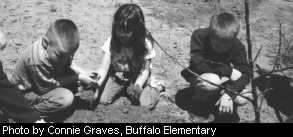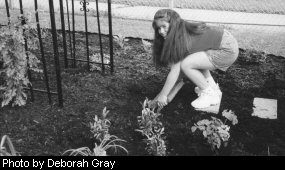

Getting Down and Dirty With Outdoor LearningBy Emily Grafton
In 1994, the West Virginia Nongame Wildlife and Natural Heritage Program launched the OWLS grant program to help schools develop outdoor environmental learning laboratories. Its mission is to instill an environmental ethic and increase students' ecological literacy through exposure to native wildlife and plant communities. Students and their teachers can design and establish a wide range of wildlife habitat features, depending on the size of the school property and/or available space adjoining the school grounds. Many schools also recruit the expertise of community volunteers such as garden club members, master gardeners and landscapers to help see their project through. The primary wildlife habitat components that must be present in an outdoor environmental learning site include food, water, shelter and space. The specific project design and plant species integrated on the site depend on the type of wildlife the school community wishes to attract and existing environmental limitations. The importance of having this program available to schools and their students is multi-faceted. The lifestyles adopted by our culture keep us isolated from the natural ecosystems underpinning the life-support systems sustaining the existence of all living things--including us. Today, much of our time is spent in cars traveling paved highways between malls, office buildings, insulated and air-conditioned homes, and sprawling school buildings. In our haste to build highways and structures, we have removed the native vegetation from our cityscapes and suburbs and replaced it with turf-grass and a few exotic species of trees. Most children have few opportunities to watch spiders spinning webs, butterflies, birds, and frogs. And, most children have no idea where the source of their drinking water is located, or how water cycles through ecosystems. As students and teachers design, establish and use their outdoor wildlife-learning site, they embark on the real-life discoveries of the native plant and animal communities that once existed where their school and homes are located. They can explore and appreciate the roles of the myriad forms of life found in a given wildlife habitat from bacteria to birds. Outdoor Wildlife Learning Sites provide opportunities for students to learn how to be good stewards of the land. Other positive aspects include: • A diverse site that can support many goals of the schools curriculum • Hands-on, reality-based learning • Increased stimulation of curiosity and creativity • Expanded teaching strategies for teachers in each subject area and grade level • Accessibility to nature • A positive example for the community Before a school community can achieve those goals, they must first plan carefully. Once students have researched the natural history of their area, they should inventory the school site. They need to find out what plants and animals currently exist, and measure the quality of the soils, water and other environmental components. With this information they can determine what kinds of projects are achievable, and what resources and resource people will be needed. And of course, they will want to apply for an OWLS grant. The grants provide up to $2,000 for any qualified West Virginia school wanting to create or enhance native plant communities and wildlife habitat components on their school grounds. Since the program's inception, the West Virginia DNR has funded sites in 36 counties of the state. The projects are as diverse as the terrain and communities existing within West Virginia. Here are some examples: Project Title: ALTIZER GARDENS Site Location: Altizer Elementary School Site Type: Urban Project Goal: Hummingbird and butterfly gardens Altizer Elementary is located in an urban neighborhood in Huntington. The only areas available for creating wildlife habitat were two grassy areas hemmed in by The first site they developed was an 800-square-foot courtyard surrounded on three sides by school walls. A hummingbird garden with native species of perennial wildflowers and shrubs was established. Hummingbird feeders were added to further entice birds to the banquet of natural nectar provided by the flowers. To further enhance the habitat for people and wildlife, volunteers added other features including benches, a small fence, a brush pile, birdbath and boulders. A 2,500 square-foot area on the school's north side was converted into a butterfly garden. Students, community volunteers and teachers all labored for hours to remove the turf-grass. Once the grass was removed, compost and mulch was added where plants were to be placed and gravel was placed in a designated walkway. Students planted native trees, shrubs and flowers in this area. A pond was installed next to a bench and trellis. Students have used the two sites for numerous scientific studies and writing projects. Project Title: BEARS (Buffalo Environmental Activity Resource Site) Site Location: Buffalo Elementary and Buffalo High School Site Type: Forest and wetland Project Goal: Improve habitats for wildlife and accessibility This project evolved from a collaboration of students, teachers and community volunteers from Buffalo Elementary, Buffalo High School and the town of Buffalo. These schools had a wonderful opportunity right in their own backyards. An approximately 12-acre bottomland forest/scrub - shrub/wetland habitat lies adjacent to the two schools. An intermittent stream bisects the area. The teachers saw a chance to improve the wildlife habitat along a trail following the stream through the scrub/shrub woodland and make it more accessible to all students for nature observation and environmental studies. Other projects were added to expand the environmental education program including the addition of a butterfly garden, compost bin, weather station and vegetable garden next to the elementary school. Students from both schools worked together on the project, and both schools use the site year-round for learning. The high school students constructed bird boxes and helped with the heavier labor of the trail maintenance. The elementary-aged students did all of the planting and do ongoing trail maintenance. Project coordinator Connie Graves says, “The students have become more excited about science through the hands-on learning opportunities provided at the OWLS site. “We have tried to make it the students' project,” she added. “Allowing them to take ownership has ensured their ongoing desire to maintain stewardship of the site.” Project Title: HIGHLANDER POND Site Location: Huntington High School Site Type: Severely altered landscape Project Goal: Restore heavily eroded banks, construct a wetland The Highlander Pond OWLS Site was established on an elongated area along the back of the school. The area was a bare, poorly drained strip of land wedged between a steep, heavily-eroded bank and the school. These conditions resulted when the school was constructed. A bulldozer was used to cut away the more gently sloping bank to increase a level surface area for constructing the building. The only post-construction environmental restoration efforts involved the planting of non-native grasses and legumes. Through the leadership of science teacher Larry Oyster, the site was inventoried and a comprehensive environmental assessment was done by several science classes. Information from the assessment was used to plan a pond and wetland habitat on the site and to restore a portion of the bank with native perennials and shrubs. “We learned so much about the environment while planning and implementing this project, especially about the importance of soils and water quality,” Oyster said. “Getting the students involved in planning, building and using the pond has generated endless opportunities for studies in biology and environmental science.” “This kind of project requires a long-term commitment and the willingness to experiment,” Grafton points out. “From the amount of endless volunteer hours being donated by the faculty, it is apparent that this project has a long life and will benefit many students in the future. Editors Note: Each OWLS site established in the state has its own unique characteristics and potential for learning, but they all take a strong commitment. The WV Wildlife Diversity Program salutes all of the teachers, students and volunteers who make these outdoor learning laboratories happen. Emily Grafton was formerly the Wild Yards and OWLS coordinator for the Wildlife Resources Section. If you would like to apply for an OWLS grant, call 304-637-0245 or email rsullivan@dnr.state.wv.us . The application deadline is November 1, each year. |
 Imagine growing up without watching polliwogs scramble in a stream, planting a garden, or listening carefully for song sparrows. One West Virginia Division of Natural Resources program actively encourages schools to provide those types of environmental opportunities, resulting in the establishment of 86 Outdoor Wildlife Learning Sites (OWLS) throughout the state.
Imagine growing up without watching polliwogs scramble in a stream, planting a garden, or listening carefully for song sparrows. One West Virginia Division of Natural Resources program actively encourages schools to provide those types of environmental opportunities, resulting in the establishment of 86 Outdoor Wildlife Learning Sites (OWLS) throughout the state.  buildings and concrete. Debbie Gray, project coordinator, and her students worked hard to convert the monoculture of turf-grass into two beautiful gardens. “Without the funds from the OWLS Grant Program,” says Gray, “we could never have provided this opportunity for the students. And, we could never have accomplished the job without the community volunteers.”
buildings and concrete. Debbie Gray, project coordinator, and her students worked hard to convert the monoculture of turf-grass into two beautiful gardens. “Without the funds from the OWLS Grant Program,” says Gray, “we could never have provided this opportunity for the students. And, we could never have accomplished the job without the community volunteers.”